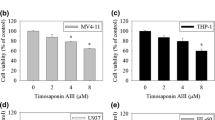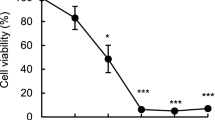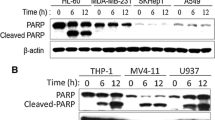Abstract
In the present study we demonstrated that the flavonoid derivative trifolin acetate (TA), obtained by acetylation of naturally occurring trifolin, induces apoptosis. Associated downstream signaling events were also investigated. TA-induced cell death was prevented by the non-specific caspase inhibitor z-VAD-fmk and reduced by the presence of the selective caspase inhibitors z-LEHD-fmk (caspase-9), z-DEVD-fmk (caspase-3) and z-VEID-fmk (caspase-6). The apoptotic effect of TA was associated with (i) the release of cytochrome c from mitochondria which was not accompanied by dissipation of the mitochondrial membrane potential (ΔΨm), (ii) the activation of the mitogen-activated protein kinases (MAPKs) pathway and (iii) abrogated by the over-expression of Bcl-2 or Bcl-xL. TA-induced cell death was attenuated by inhibition of extracellular signal-regulated kinases (ERK) 1/2 with U0126 and inhibition of p38MAPK with SB203580. In contrast, inhibition of c-Jun NH2-terminal kinase (JNK) by SP600125 significantly enhanced apoptosis. Although reactive oxygen species (ROS) increased in response to TA, this did not seem to play a pivotal role in the apoptotic process since different anti-oxidants were unable to provide cell protection. The present study demonstrates that TA-induced cell death is mediated by an intrinsic-dependent apoptotic event involving mitochondria and MAPK, and through a mechanism independent of ROS generation.





Similar content being viewed by others
References
Kroemer G, El-Deiry WS, Golstein P et al (2005) Nomenclature committee on cell death. Classification of cell death: recommendations of the nomenclature committee on cell death. Cell Death Differ 12:1463–1467
Thornberry NA, Lazebnik Y (1998) Caspases: enemies within. Science 281:1312–1316
Boatright KM, Salvesen GS (2003) Mechanisms of caspase activation. Curr Opin Cell Biol 15:725–731
Nagata S (1997) Apoptosis by death factor. Cell 88:355–365
Kluck RM, Bossy-Wetzel E, Green DR, Newmeyer DD (1997) The release of cytochrome c from mitochondria: a primary site for Bcl-2 regulation of apoptosis. Science 275:1132–1136
Yang J, Liu X, Bhalla K et al (1997) Prevention of apoptosis by Bcl-2: release of cytochrome c from mitochondria blocked. Science 275:1129–1132
Essmann F, Engels IH, Totzke G, Schulze-Osthoff K, Jänicke RU (2004) Apoptosis resistance of MCF-7 breast carcinoma cells to ionizing radiation is independent of p53 and cell cycle control but caused by the lack of caspase-3 and a caffeine-inhibitable event. Cancer Res 64:7065–7072
Cross TG, Scheel-Toellner D, Henriquez NV, Deacon E, Salmon M, Lord JM (2000) Serine/threonine protein kinases and apoptosis. Exp Cell Res 256:34–41
Kang C-D, Yoo S-D, Hwang B-W et al (2000) The inhibition of ERK/MAPK not the activation of JNK/SAPK is primarily required to induce apoptosis in chronic myelogenous leukemic K562 cells. Leuk Res 24:527–534
Middleton E, Kandaswami C, Theoharides TC (2000) The effects of plant flavonoids on mammalian cells: implications for inflammation, heart disease, and cancer. Pharmacol Rev 52:673–751
Havsteen BH (2002) The biochemistry and medical significance of the flavonoids. Pharmacol Therapeut 96:67–202
Ren W, Qiao Z, Wang H, Zhu L, Zhang L (2003) Flavonoids: promising anticancer agents. Med Res Rev 23:519–534
Díaz JG, Carmona AJ, Torres F, Quintana J, Estévez F, Herz W (2008) Cytotoxic activities of flavonoid glycoside acetates from Consolida oliveriana. Planta Med 74:171–174
Paris C, Bertoglio J, Bréard J (2007) Lysosomal and mitochondrial pathways in miltefosine-induced apoptosis in U937 cells. Apoptosis 12:1257–1267
Rubio S, Quintana J, López M, Eiroa JL, Triana J, Estévez F (2006) Phenylbenzopyrones structure-activity studies identify betuletol derivatives as potential antitumoral agents. Eur J Pharmacol 548:9–20
Bradford MM (1976) A rapid and sensitive method for the quantitation of microgram quantities of protein utilizing the principle of protein-dye binding. Anal Biochem 72:248–254
Susin SA, Lorenzo HK, Zamzami N et al (1999) Molecular characterization of mitochondrial apoptosis-inducing factor. Nature 397:441–446
Jarvis WD, Fornari FA Jr, Tombes RM et al (1998) Evidence for involvement of mitogen-activated protein kinase, rather than stress-activated protein kinase, in potentiation of 1-beta-d-arabinofuranosylcytosine-induced apoptosis by interruption of protein kinase C signaling. Mol Pharmacol 54:844–856
Yu C, Wang S, Dent P, Grant S (2001) Sequence-dependent potentiation of paclitaxel-mediated apoptosis in human leukemia cells by inhibitors of the mitogen-activated protein kinase kinase/mitogen-activated protein kinase pathway. Mol Pharmacol 60:143–154
Rubio S, Quintana J, Eiroa JL, Triana J, Estévez F (2007) Acetyl derivative of quercetin 3-methyl ether-induced cell death in human leukemia cells is amplified by the inhibition of ERK. Carcinogenesis 28:2105–2013
Laurent G, Jaffrézou JP (2001) Signaling pathways activated by daunorubicin. Blood 98:913–924
Yu R, Shtil AA, Tan TH, Roninson IB, Kong AN (1996) Adriamycin activates c-jun N-terminal kinase in human leukaemia cells: a relevance to apoptosis. Cancer Lett 107:73–81
Chen YR, Wang W, Kong AN, Tan TH (1998) Molecular mechanisms of c-Jun N-terminal kinase-mediated apoptosis induced by anticarcinogenic isothiocyanates. J Biol Chem 273:1769–1775
Shiah SG, Chuang SE, Chau YP, Shen SC, Kuo ML (1999) Activation of c-Jun NH2-terminal kinase and subsequent CPP32/Yama during topoisomerase inhibitor β-lapachone-induced apoptosis through an oxidation-dependent pathway. Cancer Res 59:391–398
Watabe M, Kakeya H, Osada H (1999) Requirement of protein kinase (Krs/MST) activation for MT-21-induced apoptosis. Oncogene 18:5211–5220
Zhuang S, Demirs JT, Kochevar IE (2000) p38 mitogen-activated protein kinase mediates bid cleavage, mitochondrial dysfunction, and caspase-3 activation during apoptosis induced by singlet oxygen but not by hydrogen peroxide. J Biol Chem 275:25939–25948
Lee K-H (1999) Novel antitumor agents from higher plants. Med Res Rev 19:569–596
Lassus P, Opitz-Araya X, Lazebnik Y (2002) Requirement for caspase-2 in stress-induced apoptosis before mitochondrial permeabilization. Science 297:1352–1354
Guo Y, Srinivasula SM, Druilhe A, Fernandes-Alnemri T, Alnemri ES (2002) Caspase-2 induces apoptosis by releasing proapoptotic proteins from mitochondria. J Biol Chem 277:13430–13437
Robertson JD, Enoksson M, Suomela M, Zhivotovsky B, Orrenius S (2002) Caspase-2 acts upstream of mitochondria to promote cytochrome c release during etoposide-induced apoptosis. J Biol Chem 277:29803–29809
Zhivotovsky B, Samali A, Gahm A, Orrenius S (1999) Caspases: their intracellular localization and translocation during apoptosis. Cell Death Differ 6:644–651
Bernhard D, Tinhofer I, Tonko M et al (2000) Resveratrol causes arrest in the S-phase prior to Fas-independent apoptosis in CEM-C7H2 acute leukemia cells. Cell Death Differ 7:834–842
Srinivasula SM, Ahmad M, Fernandes-Alnemri T, Alnemri ES (1998) Autoactivation of procaspase-9 by Apaf-1-mediated oligomerization. Mol Cell 1:949–957
Slee EA, Harte MT, Kluck RM et al (1999) Ordering the cytochrome c-initiated caspase cascade: hierarchical activation of caspases-2, -3, -6, -7, -8, and -10 in a caspase-9-dependent manner. J Cell Biol 144:281–292
Scoltock AB, Cidlowski JA (2004) Activation of intrinsic and extrinsic pathways in apoptotic signaling during UV-C-induced death of Jurkat cells: the role of caspase inhibition. Exp Cell Res 297:212–223
Milleron RS, Bratton SB (2006) Heat shock induces apoptosis independently of any known initiator caspase-activating complex. J Biol Chem 281:16991–17000
Gracie JA, Robertson SE, McInnes IB (2003) Interleukin-18. J Leukoc Biol 73:213–224
Miura M, Zhu H, Rotello R, Hartwieg EA, Yuan J (1993) Induction of apoptosis in fibroblasts by IL-1 beta-converting enzyme, a mammalian homolog of the C. elegans cell death gene ced-3. Cell 75:653–660
Friedlander RM (2003) Apoptosis and caspases in neurodegenerative diseases. N Engl J Med 348:1365–1375
Saleh M (2006) Caspase-1 builds a new barrier to infection. Cell 126:1028–1030
Guo H, Pétrin D, Zhang Y, Bergeron C, Goodyer CG, LeBlanc AC (2006) Caspase-1 activation of caspase-6 in human apoptotic neurons. Cell Death Differ 13:285–292
Gurcel L, Abrami L, Girardin S, Tschopp J, van der Goot FG (2006) Caspase-1 activation of lipid metabolic pathways in response to bacterial pore-forming toxins promotes cell survival. Cell 126:1135–1145
Virág L, Szabó C (2002) The therapeutic potential of poly(ADP-ribose) polymerase inhibitors. Pharmacol Rev 54:375–429
Oliver FJ, de la Rubia G, Rolli V, Ruiz-Ruiz MC, de Murcia G, Murcia JM (1998) Importance of poly(ADP-ribose) polymerase and its cleavage in apoptosis. Lesson from an uncleavable mutant. J Biol Chem 273:33533–33539
Nicholson DW, Thornberry NA (1997) Caspases: killer proteases. Trends Biochem Sci 22:299–306
Green DR, Kroemer G (2004) The pathophysiology of mitochondrial cell death. Science 305:626–629
Danial NK, Korsmeyer SJ (2004) Cell death: critical control points. Cell 116:205–219
Goldstein JC, Muñoz-Pinedo C, Ricci J-E et al (2005) Cytochrome c is released in a single step during apoptosis. Cell Death Differ 12:453–462
Green DR, Evan GI (2002) A matter of life and death. Cancer Cell 1:19–30
Platanias LC (2003) Map kinase signaling pathways and hematologic malignancies. Blood 101:4667–4679
Rovida E, Gozzini A, Barbetti V, Giuntoli S, Santini V, Dello Sbarba P (2006) The c-Jun-N-terminal-Kinase inhibitor SP600125 enhances the butyrate derivative D1-induced apoptosis via caspase 8 activation in Kasumi 1 t(8;21) acute myeloid leukaemia cells. Br J Haematol 135:653–659
Kuntzen C, Sonuc N, De Toni EN et al (2005) Inhibition of c-Jun-N-terminal-kinase sensitizes tumor cells to CD95-induced apoptosis and induces G2/M cell cycle arrest. Cancer Res 65:6780–6788
Xia HH, He H, De Wang J et al (2006) Induction of apoptosis and cell cycle arrest by a specific c-Jun NH2-terminal kinase (JNK) inhibitor, SP-600125, in gastrointestinal cancers. Cancer Lett 241:268–274
Zarubin T, Han J (2005) Activation and signaling of the p38 MAP kinase pathway. Cell Res 15:11–18
Galán A, García-Bermejo ML, Troyano A et al (2000) Stimulation of p38 mitogen-activated protein kinase is an early regulatory event for the cadmium-induced apoptosis in human promonocytic cells. J Biol Chem 275:11418–11424
Rockwell P, Martinez J, Papa L, Gomes E (2004) Redox regulates COX-2 upregulation and cell death in the neuronal response to cadmium. Cell Signal 16:343–353
Kummer JL, Rao PK, Heidenreich KA (1997) Apoptosis induced by withdrawal of trophic factors is mediated by p38 mitogen-activated protein kinase. J Biol Chem 272:20490–20494
Mackay K, Mochly-Rosen D (1999) An inhibitor of p38 mitogen-activated protein kinase protects neonatal cardiac myocytes from ischemia. J Biol Chem 274:6272–6279
Franklin CC, Srikanth S, Kraft AS (1998) Conditional expression of mitogen-activated protein kinase phosphatase-1, MKP-1, is cytoprotective against UV-induced apoptosis. Proc Natl Acad Sci USA 95:3014–3019
Callsen D, Brüne B (1999) Role of mitogen-activated protein kinases in S-nitrosoglutathione-induced macrophage apoptosis. Biochemistry 38:2279–2286
Juo P, Kuo CJ, Reynolds SE et al (1997) Fas activation of the p38 mitogen-activated protein kinase signalling pathway requires ICE/CED-3 family proteases. Mol Cell Biol 17:24–35
Nguyen TTT, Tran E, Nguyen TH, Do PT, Huynh TH, Huynh H (2004) The role of activated MEK-ERK pathway in quercetin-induced growth inhibition and apoptosis in A549 lung cancer cells. Carcinogenesis 25:647–659
Yeh PY, Chuang SE, Yeh KH, Song YC, Ea CK, Cheng AL (2002) Increase of the resistance of human cervical carcinoma cells to cisplatin by inhibition of the MEK to ERK signaling pathway partly via enhancement of anticancer drug-induced NF kappa B activation. Biochem Pharmacol 63:1423–1430
Tanel A, Averill-Bates DA (2007) P38 and ERK mitogen-activated protein kinases mediate acrolein-induced apoptosis in Chinese hamster ovary cells. Cell Signal 19:968–977
Acknowledgments
We thank Dr. Angelika Vollmar and Dr. Jacqueline Bréard for supplying HL-60/neo, HL-60/Bcl-xL and U937/Bcl-2 cells, respectively. We thank J. Estévez (Hospital Universitario Insular de Gran Canaria) for his collaboration in the Western blot assays. This work was supported by a Grant from the Ministry of Education and Science of Spain and from the European Regional Development Fund (SAF2004-07928) to FE. FT was supported by a research studentship from the Canary Islands Government.
Author information
Authors and Affiliations
Corresponding author
Rights and permissions
About this article
Cite this article
Torres, F., Quintana, J., Díaz, J.G. et al. Trifolin acetate-induced cell death in human leukemia cells is dependent on caspase-6 and activates the MAPK pathway. Apoptosis 13, 716–728 (2008). https://doi.org/10.1007/s10495-008-0202-0
Published:
Issue Date:
DOI: https://doi.org/10.1007/s10495-008-0202-0




